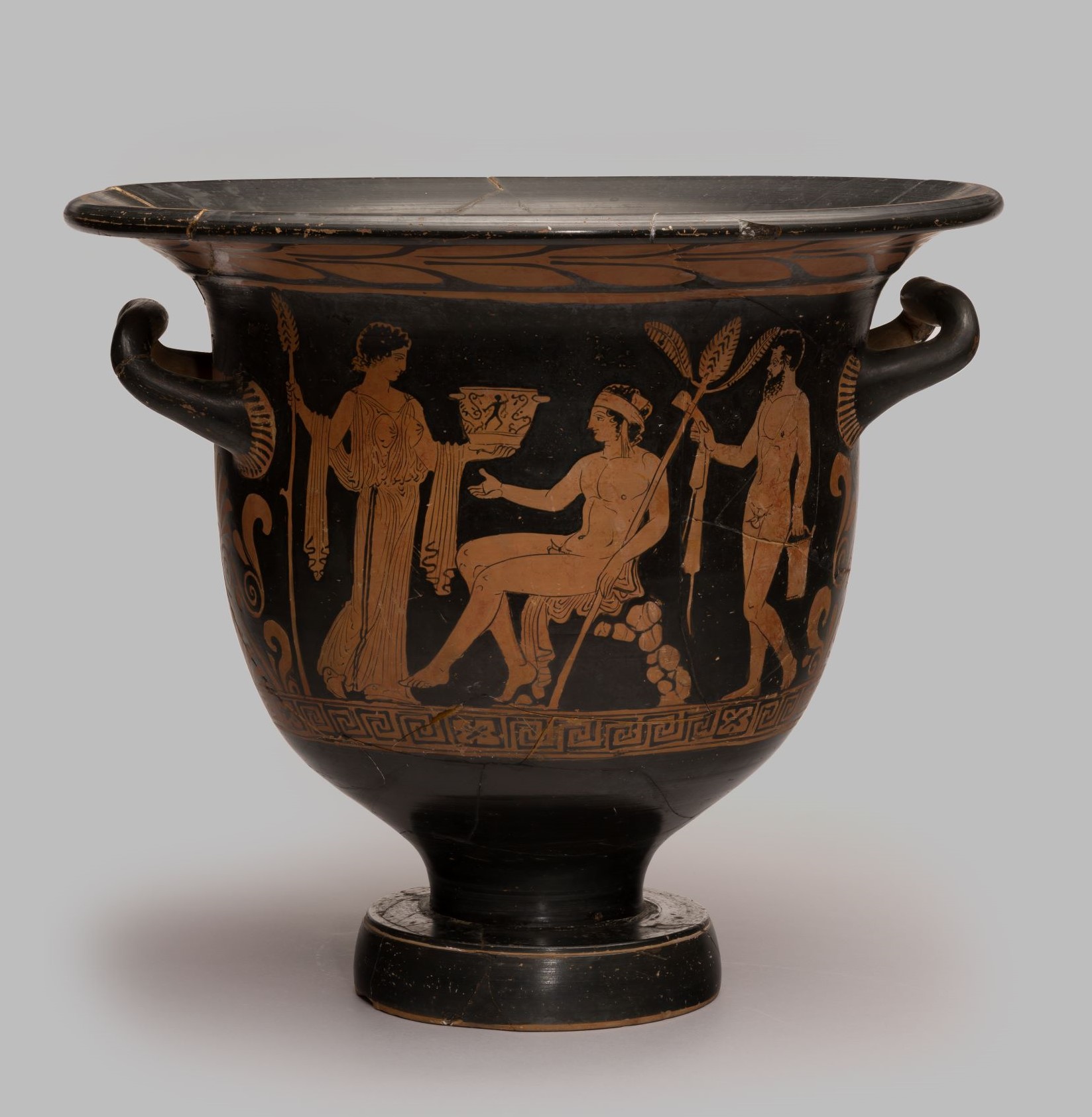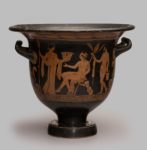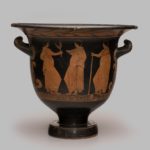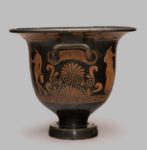
Bell Krater [Gr51]
Lucanian Red-Figure, by the Brooklyn-Budapest Painter, c. 380 BC
Painted terracotta (h. 37.8 cm, d. 43.1 cm)
Dionysus sits on a himation draped over a pile of stones, naked except for a tainia looped round his hair. In his left hand is a thyrsus. He holds out his right hand towards a maenad, who holds a thyrsus in her left hand. With her right hand, she offers a skyphos (cup) to Dionysus. Behind Dionysus stands a naked satyr holding a sash in one hand and a situla (bucket) in the other. On the other side are three draped youths. The youth on the left holds out a branch to the one in the centre, while the youth on the right looks on, leaning on his staff.
This large vase would have been used for mixing wine and water at the symposium. The name krater comes from κεραννυμι ‘to mix’. The drinking of undiluted wine was regarded by Greeks as the behaviour of uncivilised barbarians, and most accounts suggest that they mixed about three parts water to one part wine. The mixed wine would have been poured into drinking cups using a ladle or an oinochoe (wine jug).
The scene on this vase features Dionysus, the Greek god of wine. He appears with his usual companions, a maenad and a satyr. The maenad holds out a drinking cup of the steep-sided form known as a skyphos (for examples of skyphoi in Winchester’s collection see Gr11-Gr13, and Gr53). The skyphos is painted with the figure of a man dancing, suggestive of the drunken frenzy associated with Dionysus and his companions. The situla (bucket) held by the satyr, probably also contains wine. Dionysus was associated with wild places, and the pile of stones on which he sits indicates clearly that this scene takes place outdoors, far away from the civilised space of the symposium. The god and his maenad companion both hold a thyrsus, a long wand entwined with ivy leaves at the tip, that formed part of the equipment of initiates into the Dionysian mysteries. The three youths on the reverse of the vase wear the himation, which marks them out as citizens of Athens. One of them holds out what appears to be a laurel branch, ready perhaps to be formed into the crown often worn by worshippers of Dionysus.
This vase was made in one of the Greek colonies in Lucania, a region of Southern Italy. For many centuries the Greek colonists in Italy imported their painted pottery from Athens, but in the late 5th century they began to produce their own finely decorated wares. The painter of this vase was one of the leading Lucanian painters of the early 4th century, and is named after examples in the Brooklyn Museum and the Museum of Fine Arts, Budapest. The vase in Budapest includes a Dionysiac scene very similar to the present vase, though the style is looser and probably from a later phase of the painter’s career.
Literature: R. Foster, Winchester College Treasury: a guide to the collections (Winchester, 2016), p. 55; J. Falconer and T. Mannack, Corpus Vasorum Antiquorum: Great Britain, Fascicule 19: Winchester College (Oxford, 2002), p.16, plate 12.1-3; A.D. Trendall, The red-figured vases of Lucania, Campania and Sicily, third supplement (Oxford, 1983), 69.BB28; A.D. Trendall, The red-figured vases of Lucania, Campania and Sicily, 2 vols (Oxford, 1967), I, p. 112, no. 575, plate 57.1-2
Provenance: Unknown
Location: Treasury, Gallery 3


